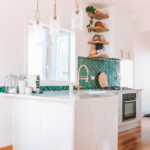Slate tiles evoke an earthy charm, transforming spaces with their rugged natural beauty and unique textural palette.
But this beauty asks for a touch of diligence in return. Like any natural stone, slate flooring demands care to ensure its longevity and luster are preserved.
This quick guide will show you how to clean slate tiles and keep them sparkling. Let’s dive in.
Key Takeaways
- Recognize the slate’s unique features and select appropriate cleaning products.
- Maintain regular sweeping and mopping to prevent damage and preserve appearance.
- Use gentle mopping techniques and tackle stains on slate floors with mild solutions.
- Seal your slate annually to protect against water, stains, and scratches.
- Consult professionals for expert advice if you plan to seal slate floors.
Identifying Slate Tile Features
Slate is a natural stone, and each tile is distinct, reflecting its geological history. You will notice variations in color and texture, as no two slate tiles are identical, providing a unique and rustic appeal.
In addition to their distinct appearance, slate tiles are also known for their durability. They are incredibly hard-wearing and able to withstand high traffic and rough treatment. This makes them an excellent choice for areas that experience heavy use.

Another advantage of slate tiles is their resistance to moisture and stains. Once sealed, slate tiles are highly resistant to water and stains, making them ideal for use in kitchens and bathrooms.
Their ability to repel moisture also helps prevent the growth of mold and mildew, ensuring a clean and healthy environment.
However, it’s important to note that despite their toughness, slate tiles can be sensitive to harsh chemicals. Strong cleaning agents can damage the surface of the tiles, leading to discoloration or other forms of damage.
It’s best to use mild, non-abrasive cleaners specifically designed for natural stone when cleaning slate tiles.
Knowing these features helps you care for your slate tiles properly, ensuring they keep their natural elegance for years to come. Regular cleaning and maintenance will help preserve their beauty and extend their lifespan.
Why It’s Important to Regularly Clean Slate Floors
Regular slate cleaning is a non-negotiable task that you must prioritize. Here’s why:
- Prevents Damage: Dust particles can act like sandpaper, wearing down your once-shiny slate surface. Regular cleaning nips this issue in the bud.
- Maintains Appearance: Frequent cleaning ensures the distinct patterns and colors of your slate tiles continue to shine through, enhancing the aesthetic appeal of your space.
- Longevity: Consistent cleaning preserves your slate tiles, prolonging the lifespan of your flooring investment.
- Health reasons: A clean floor means less dust and allergens, promoting better indoor air quality and health.
Essential Cleaning Tools and Products
Let’s dive into the essential tools and products you’ll need for effective slate tile cleaning. These items aren’t complex or hard to find, but they’re crucial for maintaining the natural beauty of your floors.
Here’s what you’ll need:
- A soft broom or vacuum cleaner: To sweep away loose debris without scratching your tiles
- Microfibre mop or damp cloth: For gentle yet effective cleaning
- Mild detergent, dish soap, or stone cleaner: These are safe for slate and won’t damage its surface
- Warm water: To aid in loosening dirt and making your cleaning solution
Recommended Cleaning Frequency
To keep your slate floors in top shape, you should stick to a regular cleaning schedule.
Daily sweeping or vacuuming is a must to keep dust and debris at bay. It’s crucial not to let dirt accumulate as it can scratch the surface of your slate tiles over time.
Mop the floors 2-3 times a week, depending on foot traffic and spill frequency.
Don’t forget about deep cleaning, too. Aim to do this once every few months or as needed. This involves a more thorough cleaning process, including stain removal and resealing.
Your slate floors will thank you for your diligence, and so will your guests.
Mopping Slate Floor Techniques

While you might think mopping your slate floors is a straightforward task, it’s important to use the correct techniques to protect and preserve their natural beauty.
Here are some mopping techniques to keep in mind:
- Always use a damp mop: Avoid soaking the slate as it can cause water damage. Wring out your mop to ensure it’s just damp, not dripping.
- Mop directionally: Start from one corner and work towards the exit, this prevents you from walking on freshly mopped sections.
- Use mild cleaners: Acidic or abrasive cleaners can damage your slate. Opt for pH-neutral cleaners instead.
- Dry your floors: After mopping, promptly dry your floors with a towel to prevent water spots and potential damage.
With these steps, you’ll maintain your slate’s gorgeous shine.
Effective Stain Removal Methods to Keep Slate Floors Clean and Spotless
Even the most meticulous homeowner can encounter some stubborn stains on their slate tiles, but don’t worry, there are numerous effective methods to tackle them.
Ordinary stains can often be removed with mild detergent and warm water. Simply apply the solution and scrub gently with a soft-bristled brush.
For tougher stains, a paste of baking soda and peroxide can work wonders. Apply the paste, let it sit for a few minutes, then scrub and rinse.
Still got a stubborn stain? Try rubbing alcohol or a mix of hydrogen peroxide and water. Always remember to rinse the area with plain water afterward.
Conclusion: Seal Slate Floors With These Simple Steps and Expert Care
Sealing your slate floor tiles is a vital part of maintaining their natural beauty and durability. Here’s why it’s important, along with some easy-to-follow tips:
- Protection Against Water: Sealer acts like a raincoat for your floors, keeping water out. Without sealing, water can seep in, causing the slate to darken and possibly damage.
- Stain Prevention: A good seal keeps spills from sinking in. That means fewer stains from coffee, wine, or anything else that might find its way to the floor.
- Scratch Resistance: Sealed slate is tougher against scratches, so your pets, chairs, and shoes are less likely to leave a mark.
- Annual Upkeep: You should seal your slate tiles once a year to keep them in top shape.
- Do the Water Test: Not sure if it’s time to reseal? Try this simple test:
- Pour water on the slate.
- Wait 10 minutes.
- Check if the water leaves a dark spot.
- If it does, it’s time to reseal.
- Different Slate, Different Needs: Keep in mind that some slate might need sealing more often. Always keep an eye out for signs of wear and test regularly.
Remember, a little bit of regular maintenance with sealing can keep your slate floor looking great for years to come.
For expert advice and professional sealing services, reach out to the pros at Stone Protection.
FAQs
What is the best thing to clean slate?
The best thing to clean slate involves using a pH-neutral floor cleaner specifically formulated for natural slate. Regularly dust mop the floor to remove debris, followed by a gentle mopping with the cleaning solution.
What cleaner to use on slate floor tiles?
When selecting a cleaner for slate floor tiles, opt for products that are designed for stone care. Avoid acidic or oil-based cleaners and choose a floor cleaner that is pH-neutral and safe for natural slate.
What should you not use on slate?
You should not use acidic cleaning products or bleach on slate, as these can etch or damage the surface. Additionally, avoid oil-based and wax-based products that can make floors slippery and dull the stone’s appearance.
How do you make slate look new again?
To make slate look new again, perform a thorough cleaning with a pH-neutral cleaner. For more heavy-duty cleaning, consider hiring professionals who can strip old sealers and apply a new penetrating sealer to enhance the stone’s natural beauty.
How do professionals clean slate floors?
Professionals clean slate floors by first removing any loose debris with a dust mop, and then using cleaning agents that are formulated for natural stone. They may also employ steam cleaners or scrubbers and typically seal the floor post-cleaning for protection.
Can I use baking soda to clean slate?
It is generally not recommended to use baking soda to clean slate, as it may be too abrasive and could alter the natural texture of the type of slate you have. Stick to pH-neutral cleaners and use a clean mop or cloth to apply.





